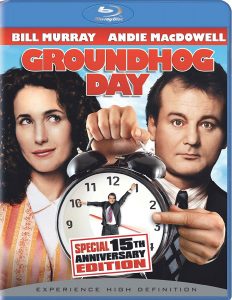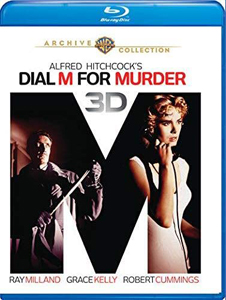“Dial M for Murder” (1954) goes through phases of whodunit, “how are they gonna do it,” “how will the frame job work” and howcatchem. The power changes hands as circumstances shift, our sympathies alternate along with the POV, and which character we see as the villain might even change.
Through all these alterations, the screenplay by Frederick Knott – working from his own stage play – is smooth as silk. And even though this is a single-angle, one-apartment “filmed stage play” like “Rope” (1948) – Alfred Hitchcock’s only color film before this one – the artistry is incredible.
The single setting — a believably modest big-city apartment for an upper-class couple of the time — provides a sense of looming nastiness, since it’s the home of Tony Wendice (Roy Milland). He smoothly plans to murder his cheating wife, Margot (Grace Kelly). Thanks to Milland’s look and performance, even before Tony announces this plan to a roped-in co-conspirator, I knew he was a schemer.

“Dial M for Murder” (1954)
Director: Alfred Hitchcock
Writer: Frederick Knott, based on his play
Stars: Ray Milland, Grace Kelly, Robert Cummings
Although Tony is the victim of infidelity, my sympathies are always with Margot and Mark (Robert Cummings). Mark just seems like a nicer guy. Even though Tony hasn’t done anything criminal up to this point, the fact that he’s spying on his wife while smiling to her and Mark’s faces means he sacrifices the moral high ground.
Although the apartment is home to both Tony and Margot, and even though many characters spend time there when Tony isn’t home, thematically this is Tony’s place. Hitchcock puts drinks (Tony is always up for one) and desk lamps (signifying that it’s his work space) in the foreground, suggesting a stage set in 2D viewing (which is how most people will see the film, of course) but even more so in 3D (which is how the film was shot).
The plot and apartment get messier
As Tony’s “perfect murder” plot gets messier – as predicted by Mark, a mystery author who admits real life is never as tidy as fiction – so does the apartment. By the end, Tony has moved his unmade bed to the living room. “Will he lie in it?” becomes the final, suspenseful question.
The director also uses 3D in the one dramatic scene – a murder attempt with a twist, which still ends up being a murder – as a woman’s arm reaches toward the audience, pulling us in. Although Hitchcock commits to the artistic possibilities of the form (despite being forced into it, as 3D was briefly the way movie theaters competed with newfangled free TV), not a single shot is 3D simply for the sake of 3D.
The murder scene is stagey, but in the best sense of the term – a centerpiece in the same way as “Psycho’s” plot-redefining shower scene. Unlike with the slow-building and misleading “Psycho,” though, we’ve been pulled in long before that desperately reaching arm by Knott and Hitchcock, and also the actors, who are perfectly cast across the board.

Milland’s Wendice has magnetic menace in addition to being the initial plot driver. Anthony Dawson’s thin-mustached Charles Swann is a thief but that doesn’t mean he deserves to be blackmailed into committing a murder – as Tony pulls off a trick the “Strangers on a Train” (1951) villain could only hope for.
John Williams comes in as Chief Inspector Hubbard, the last plot driver and the leader of a howcatchem scheme. Usually I don’t like a cop who falls for a frame job, but Hubbard redeems himself and Knott gives us an interesting situation where Hubbard has to break rules in order to do the right thing.
An ever-shifting plot
There’s already been a half-dozen twists and turns in meaning, perspective and narrative by the time we get to the last suspenseful question: What is the one little thing that’s going to make this “perfect murder” fall apart? The answer is deliciously simple and logical, although I didn’t guess it.
That final small-yet-huge overlooked element is a product of its time, but because the key to the twist is referenced in dialog before that, the film doesn’t suffer from aging. Although it was remade in 1998 as “A Perfect Murder,” it didn’t need to be.
As the characters share a final drink, I wanted to toast “Dial M for Murder” myself. Perhaps because of its single primary setting and shortage of action, it’s not often ranked as the No. 1 Hitchcock film when it goes against grander epics and psychological pieces.
This is simply character-building and plotting at its sharpest. Watching it early in a Hitchcock marathon and finding out it’s not his best entry whets my appetite for what’s to come.
IMDb Top 250 trivia
- “Dial M for Murder” ranks No. 159 among the IMDb Top 250 movies with an 8.2 rating.
- Only four Hitchcock films rank above it: “Psycho” (No. 34, 8.5), “Rear Window” (No. 51, 8.5), “North by Northwest” (No. 102, 8.3) and “Vertigo” (No. 103, 8.3).
- The only 1954 film that ranks higher than “Dial M for Murder” and “Rear Window” is “Seven Samurai” (No. 21, 8.6).
RFMC’s Alfred Hitchcock series reviews works by the Master of Suspense, plus remakes and source material. Click here to visit our Hitchcock Zone.

